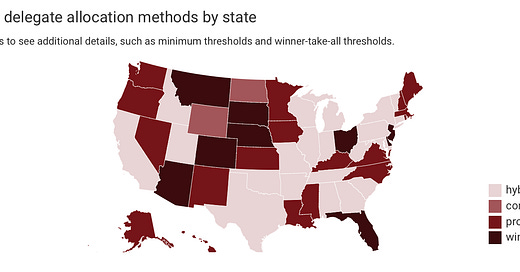Trump's 60% in primary polls could be more like 90% in delegate math
His leads pushes him just past most states' winner-takes-all delegate thresholds
Here is a short Friday notebook post. I hope you have a restful weekend before the storm. (I’m talking about Iowa, but here in DC we’re also expecting a nor'easter!)
Repeat after me: Donald Trump is the overwhelming favorite to win the 2024 Republican Party nomination for president. My polls-based model puts his odds somewhere around 95% - 99% to win. No candidate ever with this large a lead in national and state level has gone on to lose their party’s nod. That doesn’t mean something truly surprising and out of our historical training set couldn’t happen, but there’s a relatively low probability of that. Still, caveats have been issued.
So good are Trump’s odds, in fact, that I’ve said a loss at this point would be one of the most surprising political events ever — even more surprising than his shock win in 2016. But how he gets to that point matters a great deal; Winning a bare majority of delegates would be fairly weak showing for a former president. A rout, by contrast, would be a sign of great intra-party loyalty and strength heading into the general election.
On this front, I think people are dramatically underestimating just how robust Trump’s lead probably is. On paper, Trump’s 60% in national polls looks impressive already. But account for how states aware delegates to the Republican National Convention in August and a majority victory in the popular vote becomes nearly unanimous in terms of delegates. Let me show you what I mean.1
According to data accessible at Ballotpedia, roughly 1,800 delegates are up for grabs in winner-take-all (WTA) or hybrid WTA states — the latter category being states where a candidate only wins all the delegates if the pass a certain vote threshold, usually around 50%. The states using such methods are shown on this map:
Now, 1,800 delegates is a lot of delegates. In fact it’s about 600 more delegates than the majority threshold candidates are required to hit in order to win the nomination. That’s somewhere in the low 1,200s, although sources vary on the precise number needed (we should have a full official count of this out at 538 soon). That would definitely be a good showing for Trump, and better than his national polls indicate. There are around 2,400-2,500 total delegates up for grabs, so 1,800 translates to 73%.
But that’s not all! Assuming all other states allocate delegates proportionally, and relying just on the national average, Trump would win 60% of the remaining delegates. That’s 60% of 2,400 - 1,800, or 360 delegates. Add that up and you get 1,800 + 360 = 2,160 delegates, and over the full 2,400 total that’s 89% of all delegates. It’s an even higher share of delegates who are bound to vote for a certain candidate (around 95% of delegates.
So let this serve as a reminder of two important components of the GOP presidential nominating system:
There is no national primary
Delegate allocation rules matter. If all these delegates were allocated proportionally Trump would only win around 65-70% (you have to account for vote thresholds in most states). That would be a far weaker victory than 90%.
Stay tuned for more delegate math at 538 in the weeks to come.
For the purposes of this post I am going to do some rough math. Trust me, the theory holds, but if you still want more exact state-based calculations you’re going to have to wait.




